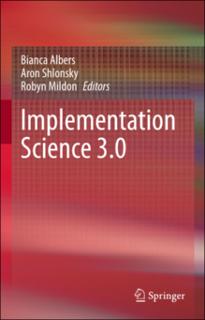| dc.contributor.author | Nilsen, P. | |
| dc.date.accessioned | 2023-01-11T12:11:45Z | |
| dc.date.available | 2023-01-11T12:11:45Z | |
| dc.date.issued | 2020 | |
| dc.identifier.citation | Nilsen, P. (2020). Making sense of implementation theories, models, and frameworks. I Implementation Science 3.0 (s. 53–79). Springer. | en_US |
| dc.identifier.uri | https://hdl.handle.net/11250/3042700 | |
| dc.description.abstract | This chapter presents a taxonomy that distinguishes among different categories of theories, models and frameworks used in implementation science. The chapter describes five categories of theoretical approaches that achieve three overarching aims: process models, which are aimed at describing and/or guiding the process of translating research into practice; determinant frameworks, classic theories and implementation theories, which are aimed at understanding and/or explaining what influences implementation outcomes; and evaluation frameworks, which are aimed at evaluating implementation. Awareness of how the approaches differ is important to facilitate the selection of relevant approaches. Most determinant frameworks provide limited “how-to” support for carrying out implementation endeavours since the determinants usually are too generic to provide sufficient detail for guiding implementation. And while the relevance of addressing barriers and enablers to implementation is mentioned in many process models, these models do not identify or structure specific determinants associated with implementation success. | en_US |
| dc.publisher | Springer | en_US |
| dc.subject | theory | en_US |
| dc.subject | model | en_US |
| dc.subject | framework | en_US |
| dc.subject | taxonomy | en_US |
| dc.subject | implementering | en_US |
| dc.subject | retningslinjer | en_US |
| dc.subject | veiledere | en_US |
| dc.title | Making sense of implementation theories, models, and frameworks | en_US |
| dc.type | Chapter | en_US |
| dc.source.pagenumber | 53–79 | en_US |
| dc.identifier.doi | https://doi.org/10.1007/978-3-030-03874-8_3 | |
